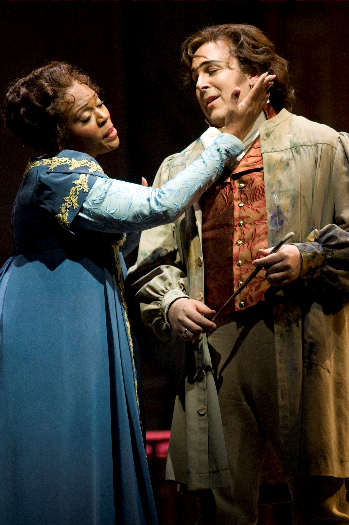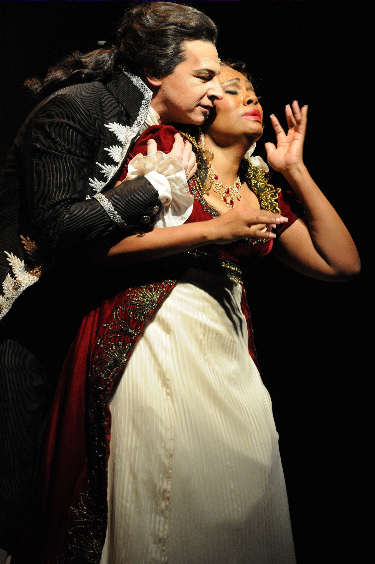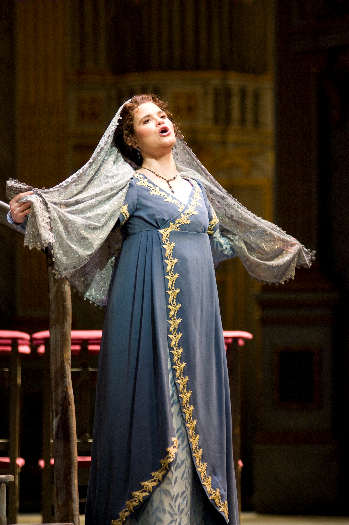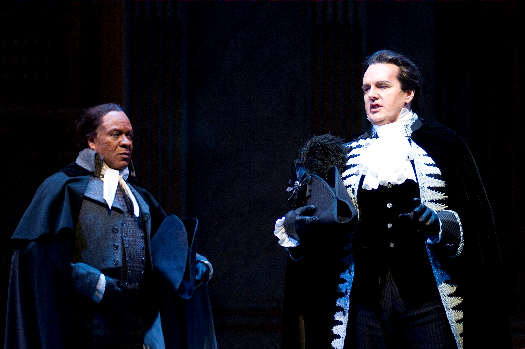Other Links
Editorial Board
- Editor - Bill Kenny
- London Editor-Melanie Eskenazi
- Founder - Len Mullenger
Google Site Search
SEEN
AND HEARD INTERNATIONAL OPERA REVIEW
Puccini, Tosca :
Seattle Opera, Soloists, cond. Vjekoslav Sutej, dir. Chris
Alexander, set designer Thierry Bosquet, costume designer Andrew,
Marlay lighting designer Connie Yun, Marion Oliver McCaw Hall,
Seattle, 24 and 27.2. 2008 (BJ)
Don’t underestimate Puccini’s characters, either. They are real
people with jobs and interests in the world, unlike the
conventional operatic tenor and soprano who, in George Bernard
Shaw’s withering phrase, really have nothing to do but “repeatedly
call attention to the fact that at last they meet again.”
Cavaradossi is a painter, and a dedicated political reformer too.
His “Vittoria! Vittoria!” in Act II, when news is brought of
Napoleon’s triumph over the Austrians at Marengo, is just one
among many examples of a complex of concerns that go far beyond
his passion for Tosca, and often conflict with it. Tosca herself
is not just some eminent person’s daughter, but an opera singer in
her own right, and a thoroughly convincing one. In this respect
they resemble, say, the Yves Montand and Simone Signoret
characters in the film La Guerre est finie, who are lovers
and people too, rather than the fluffier lovers-and-nothing-but of
many an operatic potboiler. And it must be hard, if you actually
listen to their duets with due attention to what they are saying,
not to be both charmed and touched by what comes across as a very
real relationship between two real people, a relationship
compounded of sensuality, respect, jealousy, forbearance,
intellectual sympathy, and a beguiling touch of light humor.
Sometimes it is the words that give the clue to all these traits,
but at least as often it is the music that carries the burden of
characterization.
It helps that the persons of the drama are represented, for the
most part, by singing actors who can both sing and act. As is
customary at the Seattle Opera, the principal roles are taken by
alternating casts. I went to see the production twice, in order to
see all the performers concerned, but unfortunately, in the first
Sunday matinee, the highly-regarded young tenor in what must be
called the second cast was forced by a respiratory infection to
drop out after Act I. It says much for the spirit of this company
that the first-line Cavaradossi, Frank Porretta, agreed to step in
for the rest of this matinee, though that meant he was on stage
again less than 17 hours after finishing opening night.
Musically, meanwhile, the total effect was almost as good. The
orchestra played with fire, precision, and often seductive tone
under the leadership of Vjekoslav Sutej, who moreover paced the
score to a nicety, though from my point of view this otherwise
admirable conductor provoked complaint in several respects. He cut
the two measures, after “Vissi d’arte,” in which Scarpia asks
Tosca if she has made up her mind and she asks if he wants her on
her knees at his feet–yes, I know this senseless cut is almost
always made, and even figures in the famous and unrivaled
recording with Callas conducted by Victor de Sabata, but that is
no excuse. He encouraged the audience to interrupt the drama by
very visibly applauding the singers after several arias–yes, I
know clapping after arias is also traditional, but again I find it
a nonsense. (Try to imagine a theater audience breaking into
applause when Hamlet finishes his “To be or not to be”
soliloquy!). And, most importantly, he permitted altogether too
much loud singing, and even necessitated it by letting the
orchestra play too loudly in the first place. The most glaring
instance of this came in Cavaradossi’s “Recondita armonia.” The
voice part in this aria is marked by turns piano and pianissimo;
the orchestra is directed to play “pp e dolcissimo”; but singer
and orchestra alike gave us a hearty forte. It was, I should add,
only Porretta among the principals who hardly ever abandoned the
upper levels of dynamic force. Lisa Daltirus, in particular,
achieved some wonderful dynamic contrasts, her gorgeous and
flawlessly projected voice demonstrating a capacity to draw
thrilling crescendos from notes initially floated with bewitching
delicacy. For her part, Michele Capalbo seemed to me to be in some
vocal difficulty throughout the performance I heard from her; she
possesses a voice of considerable beauty, but her line was never
quite focused. As Scarpia, Gary Simpson and Greer Grimsley were
both in fine voice, even if Grimsley, commanding artist though he
is, had better beware of a certain hardness–a lack of amplitude
around the sound–that made his singing on this occasion a shade
constricted in effect.

Lisa Daltirus (Tosca) and Frank Porretta (Cavaradossi) Cast
One
Critics, it would seem, repeatedly fall victim to the sway of the
double standard. You can see it at work in the differing critical
response to stylistic fingerprints in an intellectually okay
composer like Webern and an intellectually un-okay composer like
Shostakovich–Webern is lauded for “developing a powerfully
individual language,” Shostakovich is reviled for “repeating
himself.” Surely it is a similar duplicity of judgment that must
be suspected when the vivid portrayal of tyranny, sadism, and
sexual exploitation at their sickening work is deemed
quasi-pornographic in the suspectly popular Puccini but hailed as
profound human compassion when we encounter it in the operas of
another okay composer, Alban Berg.
Let us dispense with the double standard. Let us recognize
Tosca for what it is, which is as compelling a case-study in
man’s inhumanity to man–and woman–as any to be found in the
operatic literature. Its impact, moreover, depends at least as
much on Puccini’s musical dramatism as on the characters and
situations he and his librettists took from Victorien Sardou’s
play. For the eloquence of one musical phrase can often tell us
more about what a human being is thinking and feeling than can be
elucidated in a thousand words–which is the source of opera’s
fascination in the first place.

Greer Grimsley (Scarpia) and Lisa
Lisa Daltirus (Tosca) Cast One
So much regarding the work–and now I am delighted to report that
Seattle Opera’s new production is worthy of it. Here–praise be!–is
a director who is actually willing to present an opera as the work
its creators actually wrote, rather than as some quite different
one that he wishes they had written. There is nothing remotely
unconventional, or “Modern,” about Chris Alexander’s staging. The
characters are all recognizable human beings, and their behavior
from start to finish is exactly what their natures dictate.
Nobody, believe it or not, stands on a chair, that most egregious
cliché of contemporary directorial “thinking.” The only notable
departure from the score’s instructions came at the end of Act II,
when Tosca did not close the door when she left the stage after
killing Scarpia–but I must confess that the sight of her standing
illuminated in the doorway, looking back on the gruesome scene,
was most effective. Everything about this production works to
perfection, in a physical setting (scenery from the San Francisco
Opera, costumes originally created for the New York City Opera,
lighting design homegrown) that is sumptuous to look at and serves
the needs of the drama impeccably. Here–praise be again!–is a set
designer who can understand Italian, and who sees no reason, when
the stage directions tell him that the Attavanti chapel is on the
right and the painter’s scaffolding on the left, to up and put
them somewhere else. The physical execution, too, of Thierry
Bosquet’s conception, presenting us in turn with the interior of
the church of Sant’Andrea della Valle, Scarpia’s room in the
Palazzo Farnese, and the terrace of the Castel Sant’Angelo, with
St. Peter’s and the Vatican in the background, is done with skill
and taste, as are Andrew Marlay’s stylish costumes and Connie
Yun’s subtly modulated lighting.

Michele Capalbo (Tosca) Cast Two
Porretta, it has to be said, was perhaps the least convincing of
the principals in either cast from a dramatic point of view–he did
rather a lot of conventional operatic staggering about–but there
was no doubting his involvement in the role. The two sopranos I
saw and heard both acted splendidly, though in quite different
ways. Tosca was, as it happens, the first opera I saw when
I first came to the United States in 1964: it was performed at the
Academy of Music in Philadelphia, with the great Renata Tebaldi in
the title role. She sang marvelously, but I shall never forget the
sight of Tosca, when the man she supposedly loves was dragged on
in Act II after being tortured, carefully moving her skirt out of
the way so that it shouldn’t be stepped on. Nothing remotely like
that was perpetrated either by Michele Capalbo or by Lisa Daltirus,
who were both making their company debuts as the two Toscas in
this production. Capalbo was a charming figure on stage, and
totally believable in her realization of the character’s
suffering. But when the first-line Tosca, Lisa Daltirus, made her
appearance, a crucial difference became apparent. Both of these
sopranos have the advantage of looking lovely, but where Capalbo
offered the portrait of a charming little woman, Daltirus showed
us the authentic diva that Tosca surely must be. Scarpia is a less
complex personage, who was represented admirably both by Gary
Simpson in the matinee cast and by local favorite Greer Grimsley,
who showed us at once the evil in the character and his poisonous
charm, without quite matching the unforgettable subtlety Tito
Gobbi brought to the role, and the supporting characters, played
by the same artists in both casts, were all pointedly sketched in.

Among the smaller roles, there was not one weak link. Peter
Strummer made an entertaining Sacristan. As Spoletta, Sciarrone,
and an outrageously venal Jailer, Steven Cole, Barry Johnson, and
Byron Ellis constituted a chilling trio of petty villains of the
kind a grand villain like Scarpia depends on to do his dirty work,
and Jason Grant’s Angelotti vividly revealed the terror such a
machinery of oppression grinds into its victims. With the Shepherd
Boy’s song at the start of Act III, David Korn’s unusual and
lovely mature male soprano voice offset the prevailing sense of
foreboding with a few precious moments of heaven-sent lyricism,
and the chorus as usual showed the effects of Beth Kirchhoff’s
skilled training. I would not wish any of my strictures to detract
from the impact of what I intend as a highly enthusiastic review.
Let me put it this way: this was a superb Tosca–in many
respects a great Tosca; when a production is this good, you
want it to be even better, to have no weak points at all. But that
is a standard rarely achieved in the complex world of opera. If
you never see and hear a better production that this one, you may
die happy, and operatically well satisfied.
Pictures © Rozarii Lynch or Bill Mohn
Back
to Top
Cumulative Index Page
